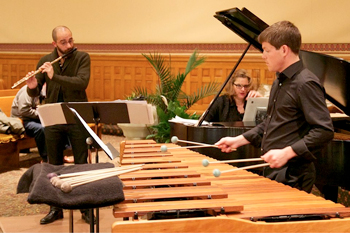by Timothy Robson

Ms. Dahl opened the concert with Ferruccio Busoni’s 1892 transcription of Johann Sebastian Bach’s Chaconne in D Minor, from the solo Violin Partita, BWV 1004. Busoni invented increasingly elaborate and virtuosic pianistic variations on Bach’s solo line. That the source material was a solo Baroque work was irrelevant in this most Romantic of piano pieces. There were a few moments of repose as the key shifted from D minor to major, but then the minor key returned for a magnificent climax. Ms. Dahl gave a fierce performance, although the acoustics of the Pilgrim sanctuary seemed a little dry for the work’s maximum effect.
The three musicians joined forces for György Kurtág’s six short Bagatelles, op. 14d in their own arrangement. Several of the movements paid off-kilter homage to J.S. Bach. Originally written for flute, piano and double bass, Mr. Nissly transcribed the bass part for marimba. Most amusing of the set was the last, “The Girl with the Flaxen Hair, Enraged,” which mixes fragments of Debussy’s piano prelude with furious music, as if the golden-haired girl was having a very serious argument.
Mr. Smith and Ms. Dahl transcribed Debussy’s Trois Chansons de Bilitis, originally for mezzo-soprano voice and piano, for flute and piano. (For unclear reasons, translations of the song texts were printed in the program. Was Mr. Smith going to forsake his flute for a vocal rendition?) In fact, they worked very well on flute, especially in a performance as expert as Mr. Smith’s. He brought out the flute’s sensuous lower register in some passages; in others, he transposed the vocal line up an octave. Ms. Dahl was a sensitive accompanist.
Mr. Nissly joined Mr. Smith for Lou Harrison’s colorful Ariadne ballet for flute and percussion (1987). In the first movement, “Ariadne Abandoned,” the flute plays a florid, desolate solo line, underlined by vibraphone notes, sometimes repeated, other times, sustained. The second movement, “The Triumph of Ariadne and Dionysos,” was a dance, using exotic scales and Mr. Nissly playing a variety of pitched drums. At the end, the flute dropped out, for a solo percussion coda.
Mr. Smith finished the first portion of the program with Toru Takemitsu’s 1995 Air for solo flute. The fantasy-like structure keeps returning to one sustained note. The themes and implied harmonies of the piece showed the influence of Takemitsu’s mentor, Olivier Messiaen.
Following intermission, it was Mr. Nissly’s turn for a solo spot in Greek composer Iannis Xenakis’s Rebonds b, for solo percussion (1989). The work had a constant pulse, but with constantly off-set accents. Mr. Nissly played drums of various pitches, from bass drum to high-pitched wooden blocks. Toward the end of the piece there was a sudden increase in the speed of the pulse and complexity of the sound to a high-pitched climax. It was fascinating to watch, and Mr. Nissly, although concentrating, seemed to be having a good time performing.
Mr. Nissly and Mr. Smith joined forces for Flutings, the first of two works by the American modernist Leon Kirchner. Mr. Nissly played vibraphone, glockenspiel, and high pitched wind chimes. The flute part was active, building to moments of tension, followed by lyric passages. Ms. Dahl followed with an impressively brilliant performance of Kirchner’s Five Pieces for solo piano, which, although written in the grand Romantic manner were in an atonal (or at very least a highly chromatic) harmonic idiom. In a lesser performance, these could have been very off-putting, but she was convincing.
Arvo Pärt’s Mozart-Adagio (1992) was composed for the Kalichstein-Laredo-Robinson Trio. In this performance flute and marimba were substituted for the original violin and cello. Pärt based his work on the second movement of Mozart’s piano sonata in F Major, K.189e (280). The sonata is deconstructed, with many “Pärt-ian” silences and a thinness of musical texture. The marimba often reinforces the bass line. Although the performance was perfectly fine, the work itself did not impress as one of Arvo Pärt’s major accomplishments.
This was a program of great variety, with something for everyone, and the expertise of the performances made even the thorniest works on the program fascinating. It proves that the oft-repeated statement that there is no audience for modern music is simply not true; it is all in how the music is presented.
Photo by Jay Szabo.
Published on ClevelandClassical.com March 27, 2013
Click here for a printable version of this article.


